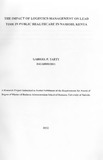| dc.contributor.author | Gabriel P. Tarty | |
| dc.date.accessioned | 2013-03-12T10:22:30Z | |
| dc.date.issued | 2012 | |
| dc.identifier.citation | MBA Thesis 2012 | en |
| dc.identifier.uri | http://erepository.uonbi.ac.ke:8080/xmlui/handle/123456789/13520 | |
| dc.description | Master Thesis | en |
| dc.description.abstract | This study establishes the factors that influence lead time and the impact logistics management
have on lead time in public healthcare in Nairobi, Kenya. The researcher makes use of
questionnaires to collect the primary data. The questionnaires consisted of two parts. The first
part contained bio data of the respondent and the second part contained questions on the
objectives of the study. Closed ended questions were used to collect the data. The questionnaire
was administered through drop and pick later method. The respondents mainly constituted
procurement officers and in some cases administrators who implemented procurement functions.
The data was analyzed by the use of factor, regression and descriptive statistics.
The analysis indicated that logistics management is influence by 10 factors that impact on lead
time among healthcare facilities in Nairobi. They included: Equipment failures; poor warehouse
management; poor flow of information; poor order shipping, poor order listing; poor order
sorting; ordering costs; bureaucracy in government; order packaging challenges and poor
warehouse planning.
The analysis also revealed that the regression results indicated that the independent variables;
demand variability, ordering costs, shortage costs, Changes in holding costs and Utilization rate
explain 64.9% of the variance in lead time changes. This is an indication that 38.1% of the
variance is explained by other variables outside the ones mentioned above.
The coefficient for x1 is 0.456 which have moderate direct relationship between demand
variability and lead time. The coefficient for ordering costs is 0.671 which is a strong direct
relationship hence very significant. The coefficient for shortage costs is -0.500 which is a
moderate inverse relationship between lead time and shortage costs. It significance tend towards
zero thus a sign that it is very important. Changes in holding costs have a strong inverse
relationship of -0.697 and a significance of zero which is an indication of very high significance.
Utilization rate has a weak direct relationship and a significance value of 0.26 which is a weak
factor.
The factors and Variables which show strong relationships to demand variability and lead time
can be taken seriously in reducing lead time in public healthcare. Healthcare providers in
Nairobi, Kenya can place more emphasis in these areas so that patients and others medical
facilities users can be served effectively and efficiently. | en |
| dc.description.sponsorship | University of Nairobi | en |
| dc.language.iso | en | en |
| dc.title | The impact of Logistics Management on lead time in public healthcare in Nairobi, Kenya | en |
| dc.type | Thesis | en |
| local.embargo.terms | 6 months | en |
| local.embargo.lift | 2013-09-08T10:22:30Z | |
| local.publisher | School of Business, University of Nairobi | en |

